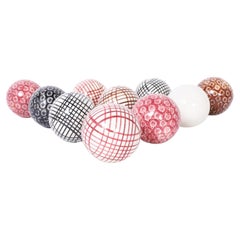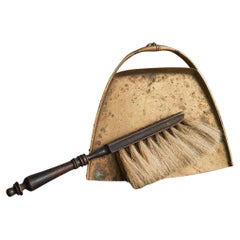Minton Folk Art
Pottery is one of the oldest decorative art forms, and Minton is one of its historical masters. For more than 250 years, the English company was a premier producer of porcelain and ceramic wares. Its factory was known for detailed and brightly colored Victorian tableware, including dinner plates and serving pieces.
Thomas Minton founded the Minton factory in 1793 in Stoke-upon-Trent, England. It initially made earthenware but introduced bone china in 1798. When Minton died in 1836, the company passed to his son, Herbert Minton. The younger Minton was a savvy businessman with an eye for design. He introduced glossy majolica earthenware to the factory’s repertoire and hired skilled artists and designers like Augustus Welby Northmore Pugin and Albert-Ernest Carrier-Belleuse, boosting the company’s reputation.
In 1851, Minton debuted its majolica at the Great Exhibition in London. It became a royal family favorite and was even used to tile the Royal Dairy at Windsor Home Park. Minton majolica was also displayed on the monumental Saint George and the dragon fountain at the 1862 London International Exhibition.
Colin Minton Campbell, a nephew of Herbert Minton, took over the family business in 1858. He led the company to the head of the 1870s English art pottery movement. In the 1890s, French porcelain artist Marc-Louis Solon helped modernize Minton with his Art Nouveau designs.
Minton ceased operating as an independent company when it merged with Royal Doulton Tableware Ltd. in 1968. It was the end of an era, but not the end of widespread appreciation for Minton ceramics.
In 1982, the ”English Majolica” exhibition at the Cooper Hewitt, Smithsonian Design Museum featured 75 Minton pieces. When the Metropolitan Museum of Art reopened its British Galleries in 2020, it included a display of three colorful Minton majolica bird sculptures. Minton pottery was also on display from September 2021 to January 2022, along with other English pottery, at the Bard Graduate Center’s ”Majolica Mania” exhibition.
On 1stDibs, find exquisite Minton serveware, decorative objects, wall decorations and more.
Mid-19th Century English Victorian Antique Minton Folk Art
Clay
Late 19th Century English Victorian Antique Minton Folk Art
Stoneware
19th Century European Victorian Antique Minton Folk Art
Brass
Early 20th Century American Industrial Minton Folk Art
Iron
Late 19th Century French Late Victorian Antique Minton Folk Art
Metal
Early 20th Century French Minton Folk Art
Wood
Late 19th Century French Late Victorian Antique Minton Folk Art
Olive
Late 19th Century French Late Victorian Antique Minton Folk Art
Metal
19th Century French Antique Minton Folk Art
Ironstone
Late 19th Century French Late Victorian Antique Minton Folk Art
Metal
1920s French Vintage Minton Folk Art
Beech
Late 19th Century French Late Victorian Antique Minton Folk Art
Olive
Late 19th Century French Late Victorian Antique Minton Folk Art
Metal, Copper, Steel
Minton folk art for sale on 1stDibs.
- What is Minton Majolica?1 Answer1stDibs ExpertApril 5, 2022Minton Majolica is a type of glazing process for pottery. Created at the Minton factory in London, Majolica is a low-temperature, colored lead glaze used on earthenware pottery. You’ll find a selection of antique Milton Majolica pieces from some of the world’s top dealers on 1stDibs.
- What are Minton tiles made of?1 Answer1stDibs ExpertApril 5, 2022Minton tiles are made with clay. Liquid clay is poured into molded patterns, and because the color is infused into the liquid clay, the tile remains durable and resistant to fading for years to come. You can shop a range of Minton products from some of the world’s top sellers on 1stDibs.
- Does Minton still exist?1 Answer1stDibs ExpertApril 5, 2022No, sadly Minton no longer exists. It was acquired by the Wedgwood group, and is now retired. The buildings that produced Minton pottery in Stoke-on-Trent, England were demolished in the 1990s and 2000s. You can shop authentic Minton designs from some of the world’s top sellers on 1stDibs.
- Is Mintons china or porcelain?1 Answer1stDibs ExpertApril 5, 2022China and porcelain can be used interchangeably, however, china gets its name from the country of origin. Products from the mid 20th century from Mintons are often referred to as ‘Minton china’ or ‘Minton.’ Mintons produces a variety of products including china, stoneware and mosaics. Shop a wide range of Minton’s pottery on 1stDibs from top sellers.


